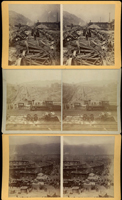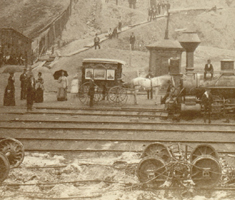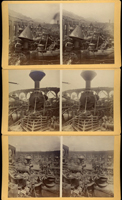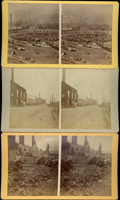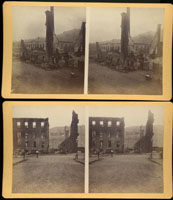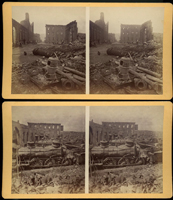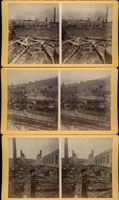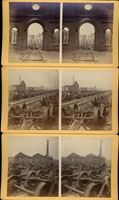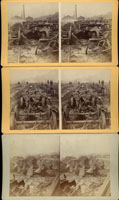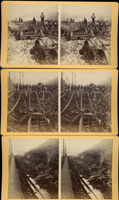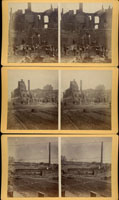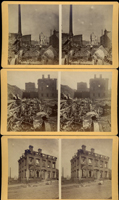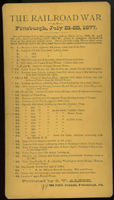HISTORIC LABOR EVENT: THE 1877 RAILROAD WAR IN PITTSBURGH
37 STEREOVIEWS
$3800.
USD
This lot contains 37 (out of 40) of The Railroad War set of stereoviews by S.V. Albee. Those that are missing are #s 26, 32, and 34.
This lot also contains a stereoview of the S.V. Albee Photo Wagon.
Only 5 have backmarks: "THE RAILROAD WAR AT Pittsburgh, July 21-22, 1877" followed with a list of views and then: "Published by S. V. ALBEE 784 (crossed out on 4 of them and replaced with a penciled in '99') Fifth Avenue, Pittsburgh, Pa." The rest simply have handwritten #s (which correspond to the list) on the backs.
Scans are in numerical order. Note that #5 shows Albee's photo wagon. We have singled that view out so that you can see the close-up of the wagon.
SIZE. Each is approximately 4 x 7 inches.
CONDITION & APPEARANCE. Please see scans.
There is an article titled Picturing Protest: The Great Railroad Strike of 1877, by Leslie Przybylek, July 19, 2017, on The Heinz History Center website (in association with the Smithsonian Institution). Here are some excerpts:
"S. V. ALBEE AND THE GREAT RAILROAD STRIKE IN PITTSBURGH, JULY 21-22, 1877. Sometime after July 22, 1877, Pittsburgh photographer S. V. Albee captured an extraordinary series of photographs. Picturing burnt machinery and twisted debris, Albee documented the local aftermath of what scholars consider the first national labor action in the United States – the Great Railroad Strike of 1877.
One hundred forty years ago this month, a labor stoppage that started on July 14, 1877 in Martinsburg, W. Va. – where workers on the Baltimore & Ohio Railroad struck to protest their third wage cut in a year – quickly spread along the nation's rail network. From Maryland to Missouri, railroad workers protested what they felt was a stranglehold by corporate interests. In a nation struggling to recover from a financial panic, with high unemployment and growing immigrant populations, tension was high. In multiple locations, sympathetic workers from other industries such as coal miners and mill workers joined in. For 45 days, national unrest reigned. Some called it the 'Great Upheaval.' Many Americans feared it was the start of another Civil War.
Pittsburgh witnessed some of the most extreme violence. Here, fury at the Pennsylvania Railroad (which announced a 10% wage cut in June) and local sympathy for the strikers prompted state officials to send in a Philadelphia-based militia force. On July 21, as these troops faced a crowd that had gathered around the 28th street crossing near Liberty Ave., pistol shots rang out. To this day, no one is sure who fired first. In response, the militia shot into the crowd, killing more than 20 people.
Stunned strikers and onlookers dispersed, but the act ultimately ignited a fiery riot. By that evening and through July 22, thousands of people flooded city streets, clashing with the militia and each other. Fire destroyed more than 30 buildings, including the Pennsylvania Railroad's Union Depot, and thousands of pieces of rolling stock, including locomotive engines and rail cars. Cannons were placed on bridges into Allegheny City to prevent the angry mob from crossing. By the time the violence began to subside, a large section of Pittsburgh lay in ruins.
S.V. Albee recorded this aftermath, composing images that emphasized the scale of the destruction. He took more than forty photographs for stereograph cards, a popular 19th century parlor amusement that allowed people to see three-dimensional views of famous scenes. That people might be interested in such images can be seen in the cards themselves, which capture onlookers strolling amid the ruins.
Albee acted quickly. By Aug. 2, 1877, he was advertising in the Pittsburgh Daily Post, announcing, 'You may never have a chance in a lifetime to secure a more interesting set of views.' He titled his set 'The Railroad War'... Today, Albee's stereographs stand as unique documentation of a key historic event, but they also remind us that photographs are not objective images. They are guided by the motives of the person behind the lens."
For the full article, go to the Heinz History Center blog.

